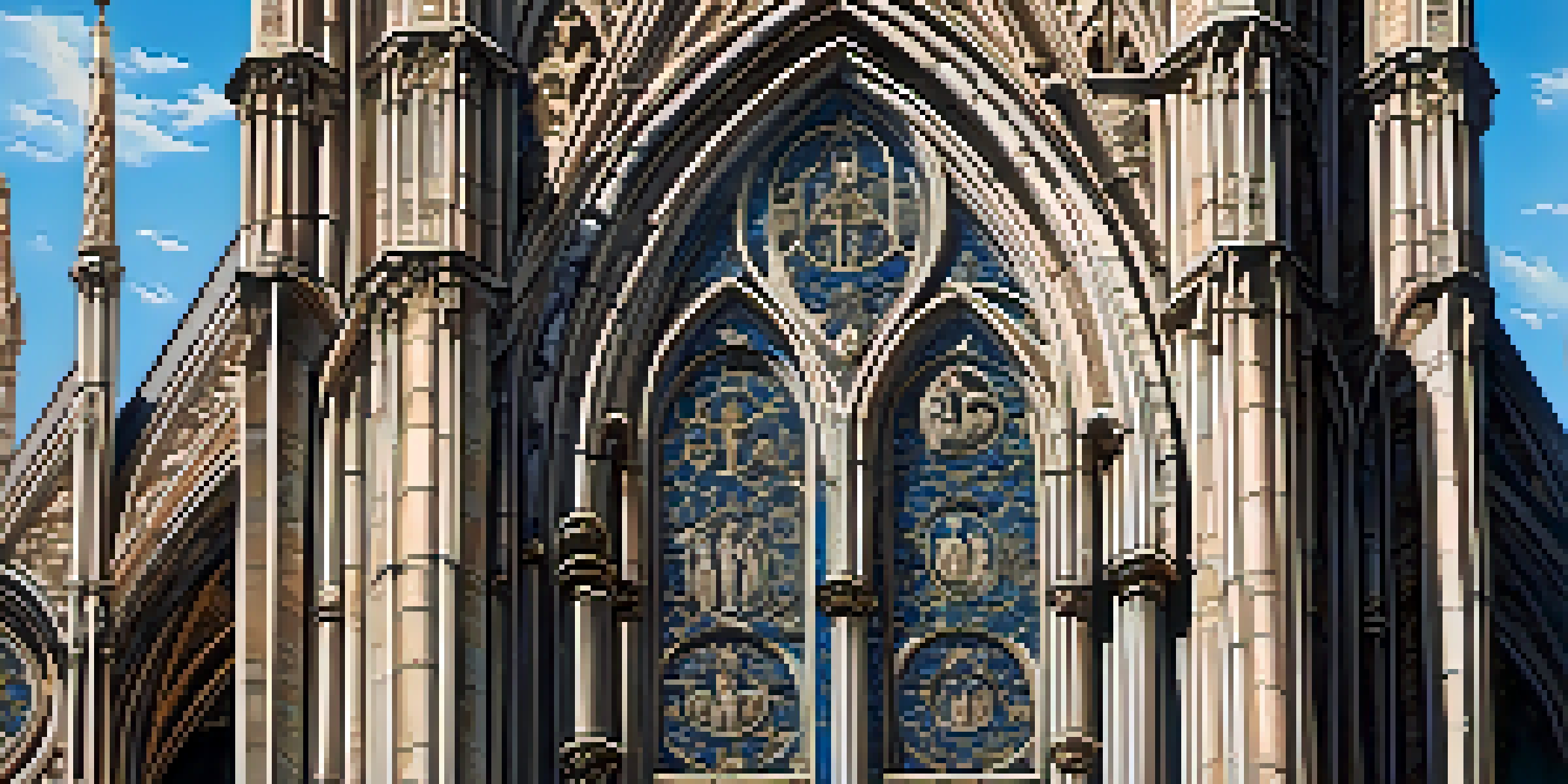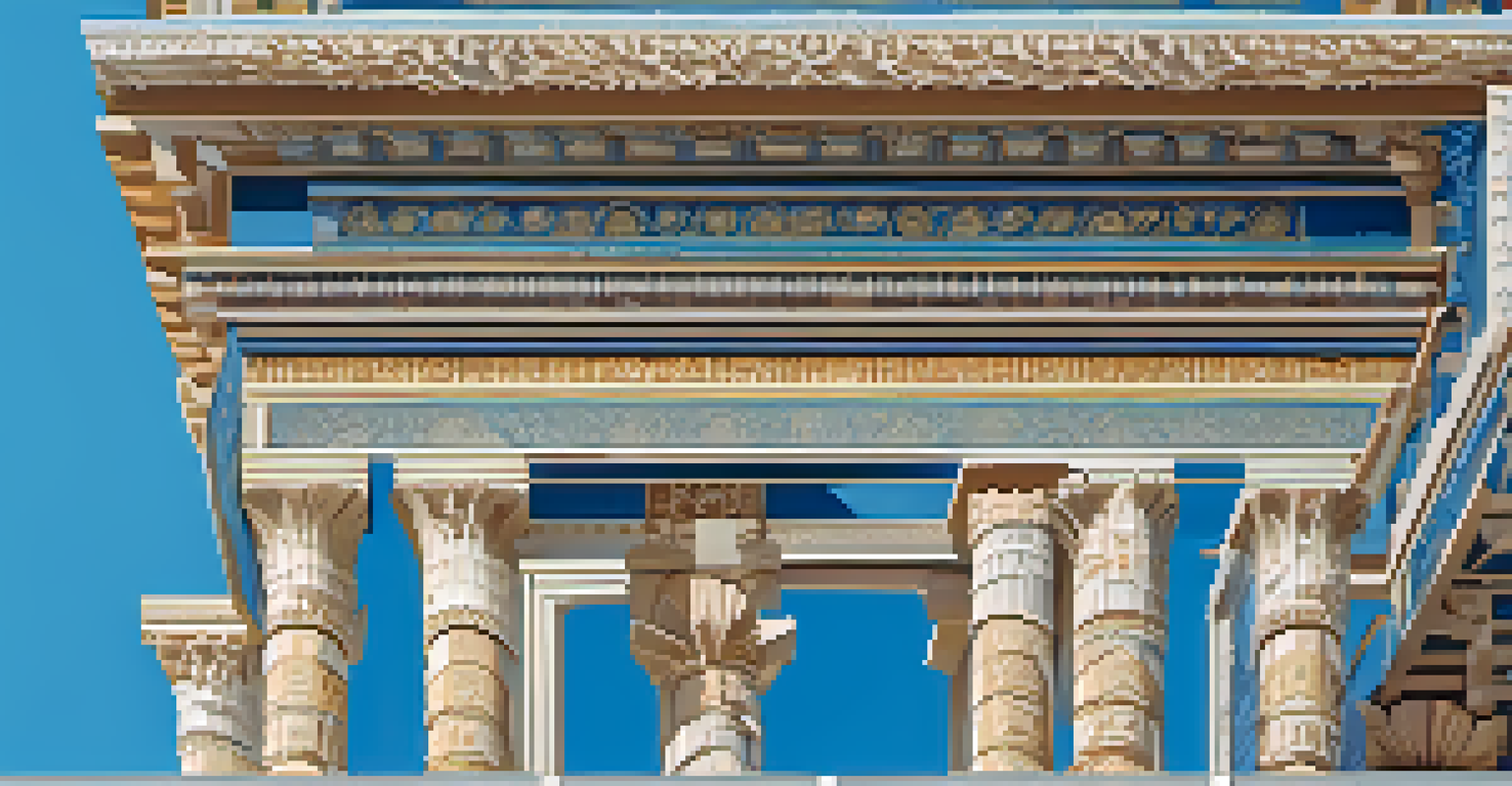Exploring Historical Carvings in Architectural Facades

The Art of Architectural Carvings Through History
Architectural carvings have been a part of building design for centuries, reflecting cultural values and artistic expressions. From ancient temples to modern skyscrapers, these intricate designs tell stories of the people and eras that created them. Each carving serves as a snapshot in time, preserving moments of history for future generations to admire.
Architecture is the learned game, correct and magnificent, of forms assembled in the light.
Take, for instance, the stunning Gothic cathedrals of Europe, where every facade is adorned with biblical figures and mythical creatures. These carvings weren’t just for decoration; they served educational purposes, teaching stories to the largely illiterate population of the Middle Ages. Similarly, the ornate designs on Indian palaces reveal the rich history and spirituality of the region.
Today, we can still find these historical carvings in cities around the world, inviting us to explore the artistry and craftsmanship that went into their creation. As we delve deeper into this topic, we'll discover how these carvings continue to influence modern architecture and design.
Symbolism Behind Historical Carvings
Many carvings are rich in symbolism, often representing religious beliefs, social status, or natural elements. For example, in ancient Roman architecture, carvings of laurel wreaths symbolized victory and honor, while carvings of animals like lions often represented strength and protection. Understanding the symbolism behind these designs can unlock deeper meanings about the cultures that created them.

In some cultures, specific motifs were used to convey messages or blessings. In Native American architecture, for instance, carvings often depict animals and natural elements that hold spiritual significance. Each carving serves as a connection to the earth and its resources, emphasizing the importance of harmony between humanity and nature.
Historical Carvings Reflect Culture
Architectural carvings serve as a visual storytelling medium, reflecting the cultural values and artistic expressions of the societies that created them.
By examining the symbolism in these historical carvings, we gain insight into the values and beliefs of past civilizations. This not only enriches our understanding of history but also inspires contemporary artists and architects to incorporate meaningful designs into their work.
Techniques Used in Historical Carving
The techniques employed in historical carvings vary widely depending on the materials and tools available at the time. Stonemasons in ancient Egypt used simple tools to create intricate hieroglyphs, while Renaissance artists employed advanced chiseling techniques to achieve depth and texture in their work. Understanding these methods helps us appreciate the skill and dedication involved in crafting each piece.
Art is the most beautiful of all lies; it is the truth that has been filtered through the soul of man.
In many cases, the choice of material also dictated the style of carving. For example, softer stones like limestone were easier to carve into detailed shapes, while harder materials like marble required more time and expertise. This difference in materials led to unique styles that are representative of various architectural movements.
As we explore these techniques, it becomes clear that historical carvings are not just random decorations; they are the result of meticulous planning and labor. This craftsmanship continues to inspire modern artisans who seek to replicate or innovate upon these time-honored practices.
Cultural Influences on Architectural Carvings
Cultural influences play a significant role in the designs and themes of architectural carvings. For instance, the intricate floral patterns found in Islamic architecture reflect the culture’s reverence for nature and its avoidance of depicting human figures. In contrast, Western architectural styles often feature more humanistic themes that celebrate the individual.
Similarly, the influence of colonialism can be seen in various architectural styles around the world, where native designs merge with European aesthetics. This fusion can be observed in buildings throughout Latin America, where Indigenous motifs are combined with Spanish colonial architecture, creating a unique and rich visual heritage.
Symbolism Enhances Historical Insight
Many carvings are imbued with symbolism, revealing deeper meanings about the religious beliefs and social structures of past civilizations.
Understanding these cultural influences not only broadens our appreciation of architectural carvings but also highlights the interconnectedness of human societies throughout history. Each carving tells a story of cultural exchange and adaptation, reminding us of our shared humanity.
Preservation of Historical Carvings
Preserving historical carvings is crucial for maintaining our cultural heritage. Over time, many of these intricate designs face threats from weathering, pollution, and neglect. Conservation efforts are essential to ensure that future generations can appreciate these artistic treasures.
Various methods are employed in the preservation process, from cleaning and restoring surfaces to replicating damaged carvings. For instance, 3D scanning technology allows conservators to create accurate replicas of original carvings, ensuring that even if the original deteriorates, the artistry continues to be celebrated.
Furthermore, raising awareness about the significance of these carvings can foster a greater appreciation and understanding of their value. Communities can engage in preservation efforts, ensuring that local history is not lost but celebrated and passed down through generations.
Modern Interpretations of Historical Carvings
Today, architects and artists draw inspiration from historical carvings to create modern designs that pay homage to the past. This reinterpretation can be seen in contemporary buildings that incorporate traditional motifs into their facades, blending old and new in exciting ways. For example, a modern office building might feature stylized versions of classical columns or intricate patterns reminiscent of ancient temples.
These modern interpretations often reflect current societal values, creating a dialogue between history and contemporary life. By merging traditional techniques with modern materials, artists can breathe new life into age-old practices, making them relevant for today’s audiences.
Preservation Ensures Cultural Legacy
Efforts to preserve historical carvings are vital for maintaining our cultural heritage and allowing future generations to appreciate these artistic treasures.
As we admire these modern designs, it becomes apparent that historical carvings continue to influence and inspire. They serve as a reminder of our architectural heritage while paving the way for innovation in the art of building.
Experiencing Historical Carvings in Person
There’s nothing quite like experiencing historical carvings in person. Visiting architectural sites allows us to appreciate the scale, detail, and artistry that may not come across in photographs. Whether it’s the grandiosity of Notre-Dame Cathedral or the delicacy of a small chapel, each site tells its own unique story through its carvings.
Guided tours often provide fascinating insights into the history and significance of these carvings, enhancing our understanding and appreciation. Many cities offer walking tours that focus on architectural history, allowing visitors to explore hidden gems and lesser-known buildings adorned with stunning carvings.

As we immerse ourselves in these experiences, we not only connect with history but also cultivate a sense of wonder and curiosity. Each carving invites us to slow down, observe, and reflect on the artistry and craftsmanship that have endured through time.